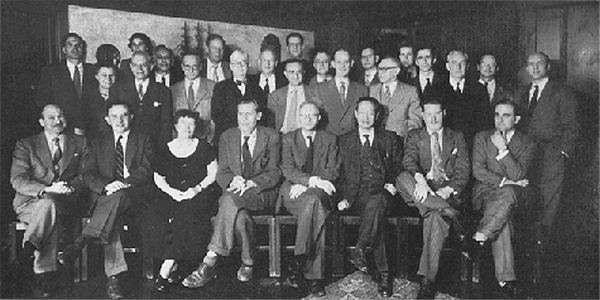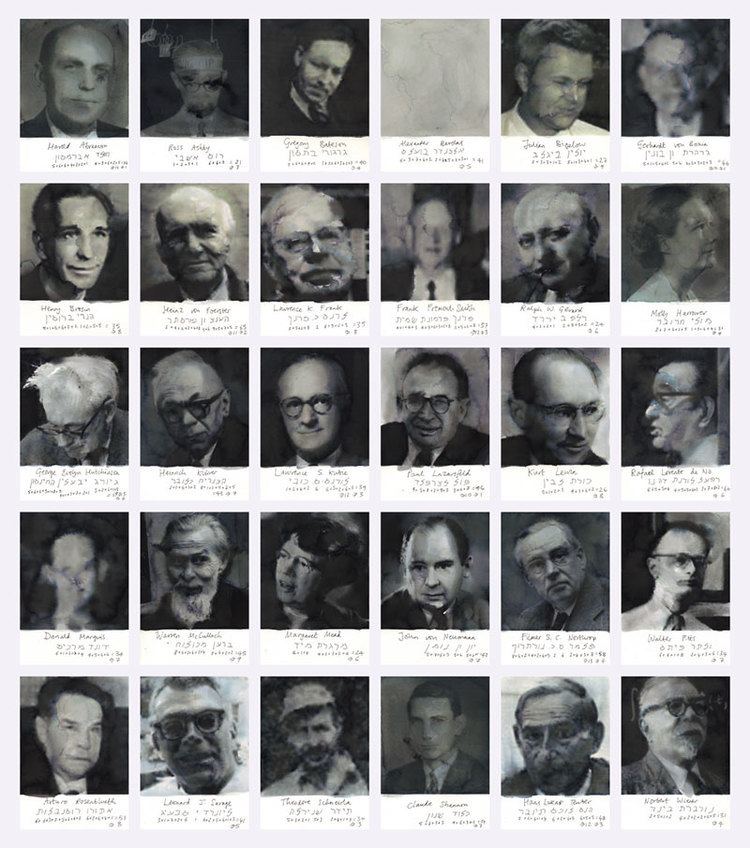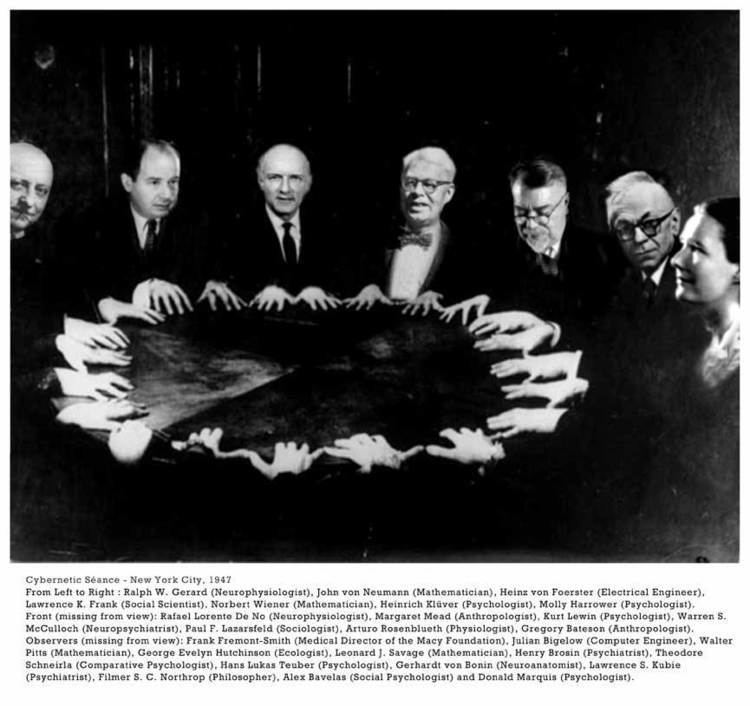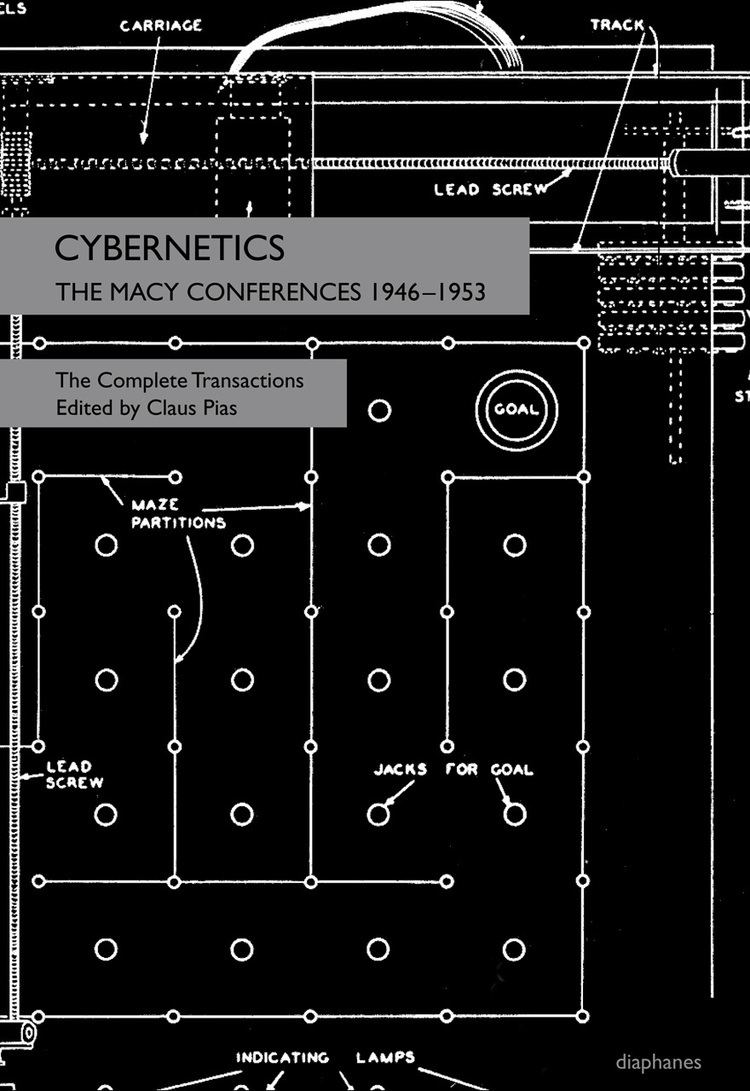 | ||
The Macy Conferences were a set of meetings of scholars from various disciplines held in New York under the direction of Frank Fremont-Smith at the Josiah Macy, Jr. Foundation starting in 1941 and ending in 1960. The explicit aim of the conferences was to promote meaningful communication across scientific disciplines, and restore unity to science. There were different sets of conferences designed to cover specific topics, for a total of 160 conferences over the 19 years this program was active; the phrase "Macy conference" does not apply only to those on cybernetics, although it is sometimes used that way informally by those familiar only with that set of events. Disciplinary isolation within medicine was viewed as particularly problematic by the Macy Foundation, and given that their mandate was to aid medical research, they decided to do something about it. Thus other topics covered in different sets of conferences included: aging, adrenal cortex, biological antioxidants, blood clotting, blood pressure, connective tissues, infancy and childhood, liver injury, metabolic interrelations, nerve impulse, problems of consciousness, and renal function.
Contents
- Overview
- Cerebral Inhibition Meeting
- Cybernetics Conferences
- Neuropharmacological Conferences
- Group Processes Conferences
- References

Overview

The Josiah Macy, Jr. Foundation developed two innovations specifically designed to encourage and facilitate interdisciplinary and multidisciplinary exchanges; one was oral: the Macy conferences, and one was written: the Macy transactions (published transcriptions of the conferences). Macy conferences were essentially conversations held in a conference setting, with participants presenting research while it was still in process (rather than after it had been completed). These were more formal than conversations (papers were prepared ahead of time and circulated) but less formal than conferences. Macy transactions were transcriptions widely circulated to those who could not attend. These were far more informal than typical proceedings, which publish revised versions of conference papers, and served to invite additional scholars into the exchange. The explicit goal was to let a wider audience hear the experts exchange ideas and think out loud about their own work. But even participants themselves found the transactions valuable, as a way to prompt memories, and to catch comments they might have missed. A few comments were made explicitly referring to later publication of the conference discussions, so clearly participants took this into account. However, Fremont-Smith explicitly stated that actual discussion should always take priority.

Participants were leading scientists from a wide range of fields. Casual recollections of several participants as well as published comments in the Transactions volumes stress the communicative difficulties in the beginning of each set of conferences, giving way to the gradual establishment of a common language powerful enough to communicate the intricacies of the various fields of expertise present. Participants were deliberately chosen for their willingness to engage in interdisciplinary conversations, or for having formal training in multiple disciplines, and many brought relevant past experiences (gained either from earlier Macy conferences or other venues). As participants became more secure in their ability to understand one another over the course of a set of conferences on a single topic, their willingness to think outside their own specializations meant that creativity increased.
Cerebral Inhibition Meeting

The Macy Cybernetics Conferences were preceded by the Cerebral Inhibition Meeting, organized by Frank Fremont-Smith in May 1942. This was an invitation only meeting attended by:
There were two topics:
Cybernetics Conferences

The Cybernetics conferences were held between 1946 and 1953, organized by the Josiah Macy, Jr. Foundation, motivated by Lawrence K. Frank and Frank Fremont-Smith of the Foundation. As chair of this set of conferences, Warren McCulloch had responsibility to ensure that disciplinary boundaries were not unduly respected. The Cybernetics were particularly complex as a result of bringing together the most diverse group of participants of any of the Macy conferences, so they were the most difficult to organize and maintain.

The principal purpose of these series of conferences was to set the foundations for a general science of the workings of the human mind. These were one of the first organized studies of interdisciplinarity, spawning breakthroughs in systems theory, cybernetics, and what later became known as cognitive science.
Participants: (as members or guests) in at least one of the Cybernetics conferences: Harold Alexander Abramson, Ackerman, Vahe E. Amassian, William Ross Ashby, Yehoshua Bar-Hillel, Gregory Bateson, Alex Bavelas, Julian H. Bigelow, Herbert G. Birch, John R. Bowman, Henry W. Brosin, Yuen Ren Chao, Jan Droogleever-Fortuyn, M. Ericsson, Fitch, Lawrence K. Frank, Ralph Waldo Gerard, William Grey Walter, Molly Harrower, George Evelyn Hutchinson, Heinrich Klüver, Lawrence S. Kubie, Paul Lazarsfeld, Kurt Lewin, J. C. R. Licklider, Howard S. Liddell, Donald B. Lindsley, W. K. Livingston, David Lloyd, Rafael Lorente de Nó, R. Duncan Luce, Donald M. MacKay, Donald G. Marquis, Warren S. McCulloch, Turner McLardy, Margaret Mead, Frederick A. Mettier, Marcel Monnier, Oskar Morgenstern, F. S. C. Northrop, Walter Pitts, Henry Quastler, Antoine Remond, I. A. Richards, David McKenzie Rioch, Arturo S. Rosenblueth, Leonard J. Savage, T. C. Schneirla, Claude Shannon, John Stroud, Hans-Lukas Teuber, Mottram Torre, Gerhardt von Bonin, Heinz von Foerster, John von Neumann, Heinz Werner, Norbert Wiener, Jerome B. Wiesner, J. Z. Young.
This is a sampling of the topics discussed each year.
Some of the researchers present at the cybernetics conferences later went on to do extensive government-funded research on the psychological effects of LSD, and its potential as a tool for interrogation and psychological manipulation in such projects as the CIA's MKULTRA program.
Neuropharmacological Conferences
Participants: William Borberg, Seymour Kety, Ernest Sharrer, Mary Brazier, Horace Magoun, Carl Pfieffer Topics: LSD
Group Processes Conferences
The Group Processes Conferences were held between 1954 and 1958. They are of particular interest due to the element of reflexivity: participants were interested in their own functioning as a group, and made numerous comments about their understanding of how Macy conferences were designed to work. For example, there were a series of jokes made about the disease afflicting them all, interdisciplinitis., or how multidisciplinarian researchers were neither fish nor fowl. When Erving Goffman made a guest appearance at the Third conference, he explicitly prefaced his comments by saying that his ideas were partly speculative, and Frank Fremont-Smith responded by stating that their goal was to discuss ideas that had not been crystallized.
Participants: (as members or guests) in at least one of the Group Processes conferences: Grace Baker, Donald H. Barron, Gregory Bateson, Alex Bavelas, Frank A. Beach, Leo Berman, Ray L. Birdwhistell, Robert L. Blake, Helen Blauvelt, Jerome S. Bruner, George W. Boguslavsky, Charlotte Bühler, Eliot D. Chapple, Stanley Cobb, Nicholas E. Collias, Jocelyn Crane, Erik H. Erikson, L. Thomas Evans, Jerome Frank, Frank S. Freeman, Frieda Fromm-Reichmann, Erving Goffman, Arthur D. Hasler, Eckhard H. Hess, Sol Kramer, Daniel S. Lehrman, Seymour Levy, Howard Liddell, Robert Jay Lifton, Margarethe Lorenz, Konrad Z. Lorenz, William D. Lotspeich, Ernst Mayr, Margaret Mead, Joost A. M. Meerloo, I. Arthur Mirsky, Horst Mittelstaedt, A. Ulric Moore, R. C. Murphy, Harris B. Peck, Karl H. Pribram, Fritz Redl, Julius B. Richmond, Bertram Schaffner, T. C. Schneirla, Theodore Schwartz, William J. L. Sladen, Robert J. Smith, John P. Spiegel, H. Burr Steinbach, Niko Tinbergen, Mottram P. Torre, William Grey Walter, E. P. Wheeler, II.
